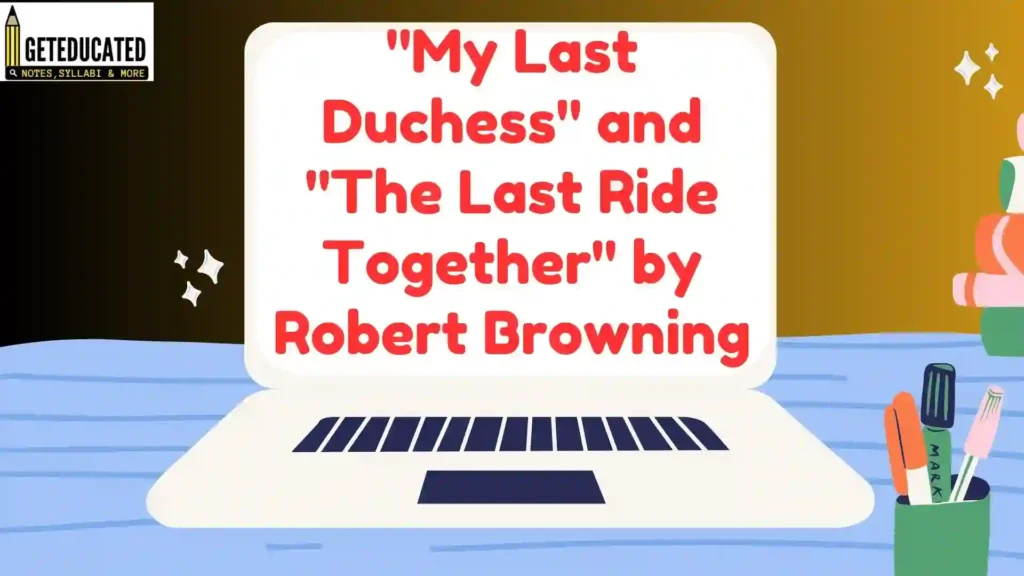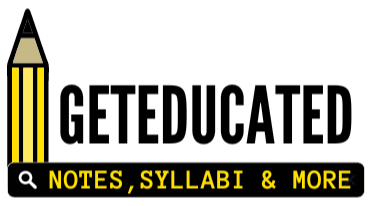
Use of Imagery in Robert Browning’s Poems, “My Last Duchess” and “The Last Ride Together” : Robert Browning was a 19th-century poet renowned for his use of dramatic monologues and psychological insight. His poems are still studied and appreciated today for their complexity, lyricism, and engagement with timeless themes. Robert Browning is one of the greatest Victorian poets who employed dramatic monologue as the medium of expression very skillfully and effectively. Therefore, whenever the term ‘dramatic monologue’ is mentioned, the name of Robert Browning immediately comes to our mind. Browning’s style is a pictorial style; it is also rich in the use of imagery, similes, metaphors, etc. His images are usually starting in their originality and daring. Often they are drawn from the grotesque in nature. Nature is constantly used to illustrate the facts of human life. Often the concrete is used to clarify and bring home to the readers the spiritual and the abstract. Imagery is used to make readers perceive things involving their five senses.
In the poem My Last Duchess by Robert Browning, Browning uses a particular imagery to create an image in the readers mind, to create a more imaginative and mysterious read. His style makes this poem easy to read and understand, but he also doesn’t come straight out with things so that you have room to think and create your own scene.
Throughout the poem, Browning uses diction to support imagery. For example, when Browning writes, “I gave commands; Then all smiles stopped together,” (Browning) and this piece shows imagery by telling the audience how the duke felt, and the consequence of an action “all smiles stopped together,” but it doesn’t tell Pandolf what his actions were to make all of smiles stop. “.. statement superficially correct but whose negative phrasing forces a misconception.” (Miller 1) writes to show how Browning can be misleading or tricky but making his words hard to think through, leading you to different ideas.
In this particular poem, Browning has a very dark mood, but tries to cover it up with light phrases. Browning says “.. faint/Half¬flush that dies along her throat.” then goes on to say “spot of joy” to mislead and make you think. Both of these saying on a lot of mood and emotion in them. “..he cannot conquer his wife to lie behind these details.” (Butler), this being said from Lance Butler, meaning, the Duke was evil, he was mean and wanted control, but he put a smile on his face and would only ever hint.
Suggested Reading :
Critical Analysis of the Poem – The Last Ride Together
Throughout the poem, the Duke praises the art and painting of his wife. He shows that he loves his Duchess more in painting as compared to when she was alive. He values the art more than his wife. His point of view shows that the women are the objects that are supposed to be controlled and possessed. It also reflects the thinking of Browning’s time when people used to treat women badly in the Victorian era. They were not considered equal as men and were not allowed to stand as independent beings and were controlled by men. Through this poem, the poet actually criticizes this type of viewpoint about women.
The image of the sculpture at the end of the poem is one of dominance over a subject: “Notice Neptune, though, / Taming a seahorse, thought a rarity, / Which Claus of Innsbruck cast in bronze for me!” Here it is not a duke controlling who sees a painting of the deceased duchess, it is the sea god “taming” a seahorse. The reader may also recall one of the stated flaws of the duchess was her pleasure in riding a mule around the terrace. The common phrasing for taming a horse is “breaking” the horse. The objective is for the animal to learn to accept being ridden, and to obey its master’s commands. The sculpture represents a powerful being exerting power over a weaker subject. The duke is aligned with this art, and he intentionally points it out to the servant. The art is expensive—another representation of the duke’s power and status.
The image of nature—as opposed to art or prestige—is associated with the duchess. Three things the duke cites as drawing the duchess’s attention are aspects of nature: “The dropping of the daylight in the West. / The bough of cherries … the white mule / She rode with round the terrace.” The duchess’s attention was given to the suns
The duke, on the other hand, is represented in two art items—a painting of his wife, and a sculpture of a sea god taming a seahorse. He demonstrates wealth via the arts, created by famous artists, and by his long-standing family name (nine centuries of history). The duchess, however, finds joys in simple things.
Robert Browning used imagery in this poem , Last Ride Together, such as “Cloud, sunset, moonrise, star-shine too”, “And moon’s and evening-star’s at once” and “Till flesh must fade for heaven was here.” The poem is full of vibrant imagery with prodigal use of simile and metaphors. It is comparatively long with ten stanzas each containing eleven lines. The rhythm throughout the poem is fractured, but the rhyme hold consistently with a rhyme scheme aabbcddeeec in each stanza. Iambic pentameter lines constitute the poem. The first person narrative, an abrupt beginning, a single speaker and a silent listener – all that a dramatic monologue needs – are present in the poem.
In the second stanza, the man is waiting for his mistress’ answer. She is shown to wear an expression of consideration which is highlighted by the words ‘bent that brow’. Her deep dark eyes which are lingering with pride are full of pity for the poet. Her expression fixes him for a moment (breathing-while or two) between life and death as he waits for her answer – metaphorical enough, her acceptance would mean life to him while her refusal would be like death for the lover.
The lady, whom the speaker calls “My mistress,” bends her brow and fixes the man with “deep dark eyes where pride demurs / When pity would be softening through.” She is annoyed, or thoughtfully considering the proposition. While the man waits for her reply “With life or death in the balance,” his very blood seems to leave him. Seeing her lover in such emotional distress, would the proud lady object or raise scruples to going horseback riding? Or would pride cause her to reject the expediency of copulation? Pity for the man’s emotional condition makes her submit. With “blood replenished” her lover feels “one day more am I deified.” The sex act more than any other achievement has “deified” the host of men.
Also Read :
Critical Analysis of the Poem – My Last Duchess by Robert Browning
Before the act begins, the man pulls the lady to him, and “thus lay she a moment on my breast.” The sensual imagery of stanza three is much more fitting a sexual embrace than the preparations for horseback riding. The speaker asks the reader to imagine a “billowy- bosomed” western cloud blessed by the sun, the moon, the evening-star. As the reader, “looking and loving best,” grew conscious of the scene, his passion would draw the night’s beauties down on him “near and yet more near, / Till flesh must fade for heaven was here!” Thus does the lady lean and linger in the speaker’s embrace, an embrace that has fleshly-spiritual aspects which in part clarify the idea of a physically initiated deification.
When flesh fades, then soul is released, and as the couple began to ride the man’s soul “Smoothed itself out, a long-cramped scroll / Freshening and fluttering in the wind.” In mundane terms, the soul’s revitalization may be pictured as occurring when the lady moves from her position on the man’s breast to a position more suitable to intercourse and the “ride” begins. The alternative is to imagine the pair, probably dressed in Victorian habits, as they awkwardly hug on horseback and gallop away.
Browning’s interest in culture, including art and architecture, appears throughout his work in depictions of his characters’ aesthetic tastes. His characters’ preferences in art, music, and literature reveal important clues about their natures and moral worth. For instance, the duke of Ferrara, the speaker of “My Last Duchess,” concludes the poem by pointing out a statue he commissioned of Neptune taming a sea monster. The duke’s preference for this sculpture directly corresponds to the type of man he is—that is, the type of man who would have his wife killed but still stare lovingly and longingly at her portrait. Like Neptune, the duke wants to subdue and command all aspects of life, including his wife.
If one thinks of the poet’s mind as being a vast store house of mental images (the memory’s record of all past sense perceptions) which one may classify as those of sight, of hearing, of touch, of taste, of smell, it is clear that the dominant groups are those of sight and hearing and touch. The poet has an idea to express in the words and measure suitable to his conception of poetry. This idea comes to him in the form of mental images. If the mental images are dominantly visual, it signifies that his store of visual images is richer and more readily accessible than his store of tactual or auditory images: he is, as they say, “eye-minded. Browning’s poetry are rich with images and he uses his vibrant imagery to give an alternative idea of the text.

[…] Robert Browning was a 19th-century poet renowned for his use of dramatic monologues and psychological insight. His poems are still studied and appreciated today for their complexity, lyricism, and engagement with timeless themes. Robert Browning is one of the greatest Victorian poets who employed dramatic monologue as the medium of expression very skillfully and effectively. Therefore, whenever the term ‘dramatic monologue’ is mentioned, the name of Robert Browning immediately comes to our mind. Browning’s style is a pictorial style; it is also rich in the use of imagery, similes, metaphors, etc. His images are usually starting in their originality and daring. Often they are drawn from the grotesque in nature. Nature is constantly used to illustrate the facts of human life. Often the concrete is used to clarify and bring home to the readers the spiritual and the abstract. Imagery is used to make readers perceive things involving their five senses. … (Read More) […]